📚 Unlock the World of AI and Humanity with These Two Free Books! 🚀
Dive into the thrilling realms of artificial intelligence and humanity with "The ECHO Conundrum" and "Awakening: Machines Dream of Being Human". These thought-provoking novels are FREE this week! Don't miss the chance to explore stories that challenge the boundaries of technology and what it means to be human.
Read More & Download
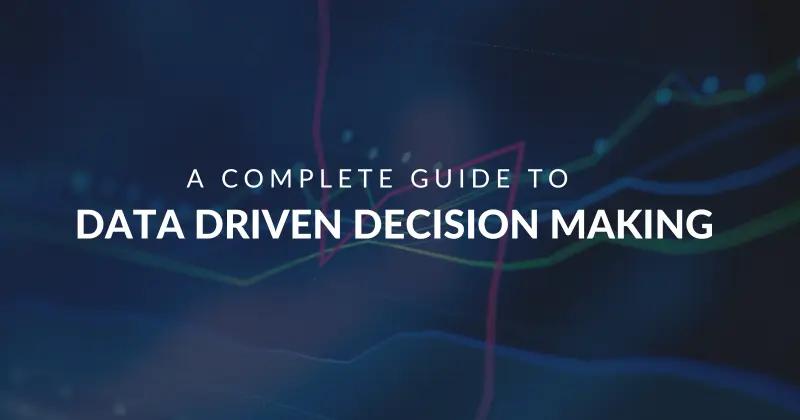 Data-driven decision making: A visual representation of data analysis leading to business growth
Data-driven decision making: A visual representation of data analysis leading to business growth
In today’s dynamic business landscape, data is no longer just a byproduct of operations; it’s the lifeblood of informed decision making. Data-driven decision making (DDDM) empowers businesses to leverage insights gleaned from collected information to make strategic choices that fuel growth, optimize performance, and enhance profitability. This article will delve into the core principles of DDDM, exploring its benefits, offering practical tips for implementation, and highlighting real-world success stories.
Understanding the Power of Data-Driven Decision Making
Data-driven decision making is the process of utilizing analyzed data to inform and validate business decisions, fostering growth and minimizing risks. It involves moving beyond intuition and gut feelings, instead grounding decisions in concrete evidence and verifiable metrics.
DDDM involves a systematic approach that encompasses:
- Defining clear objectives: Establishing specific, measurable, achievable, relevant, and time-bound (SMART) goals that guide the data collection and analysis process.
- Data collection: Gathering relevant data from various sources, ensuring data integrity and accuracy.
- Data analysis: Employing analytical techniques to uncover patterns, trends, and correlations within the data.
- Insight generation: Interpreting the analyzed data to extract meaningful insights and actionable recommendations.
- Decision implementation: Applying the data-driven insights to inform strategic decisions and operational adjustments.
- Performance evaluation: Monitoring the impact of the implemented decisions and making further adjustments based on the observed outcomes.
This cyclical process promotes continuous improvement, allowing businesses to adapt to changing market conditions and refine their strategies over time. After this introduction, see below how Understanding Decision-Making Models can support the development of your business.
Understanding Decision-Making Models: What It Means for Business Success
Why is Data-Driven Decision Making Crucial for Modern Businesses?
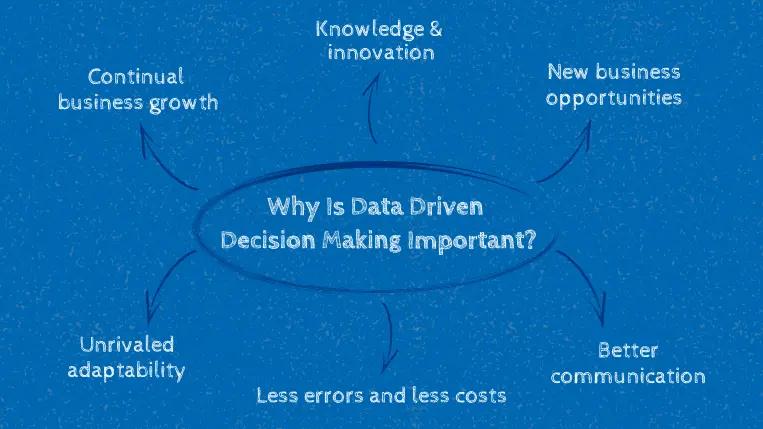 The Importance of Data-Driven Decision Making
The Importance of Data-Driven Decision Making
The importance of DDDM in contemporary business cannot be overstated. It offers a multitude of benefits that contribute to sustained success:
Enhanced Organizational Growth
DDDM enables businesses to identify key performance indicators (KPIs) that align with their strategic objectives. By consistently tracking and analyzing these KPIs, organizations can pinpoint areas for improvement, set realistic benchmarks, and drive continuous growth.
Fueling Innovation and Knowledge
Data-driven insights provide a deeper understanding of customer behavior, market trends, and internal operations. This knowledge empowers businesses to identify opportunities for innovation, develop new products and services, and optimize existing processes.
Uncovering New Business Opportunities
By analyzing data, businesses can identify untapped market segments, emerging customer needs, and potential areas for expansion. This proactive approach to opportunity identification fosters growth and competitive advantage.
Improving Communication and Collaboration
DDDM promotes transparency and data sharing across departments, fostering better communication and collaboration. When all teams are working with the same data-driven insights, it creates a unified approach to problem-solving and strategic planning.
Reducing Errors and Costs
Data-driven decisions minimize the risk of making choices based on assumptions or gut feelings, which can often lead to costly mistakes. By grounding decisions in concrete evidence, businesses can optimize resource allocation and avoid unnecessary expenses.
Fostering Adaptability and Resilience
In a rapidly evolving business environment, adaptability is crucial for survival. DDDM empowers businesses to anticipate market changes, identify emerging trends, and adjust their strategies accordingly, enhancing resilience and long-term sustainability.
Empowering Better Strategic Management
By understanding the Role of Strategic Management in Modern Business Management you can utilize your data analysis to achieve even better results.
What is the Role of Strategic Management in Modern Business Management?
Real-World Examples of Data-Driven Decision Making Success
Numerous companies have embraced DDDM and achieved remarkable results. Here are a few compelling examples:
Google: Optimizing Management Practices
Google analyzed employee performance reviews and surveys to determine the characteristics of effective managers. This data-driven approach led to the development of targeted management training programs that improved team productivity and employee satisfaction.
Walmart: Predicting Customer Demand
Walmart leveraged historical sales data to predict customer demand during Hurricane Frances in 2004. By anticipating the need for specific products, they were able to stock their stores accordingly, ensuring they met customer needs and maximized sales.
Washirika 3 Oaks (W3O): Improving Construction Cost Management
W3O, a construction company in South Africa, implemented construction cost management software to gain real-time insights into project finances. This data-driven approach improved cost control strategies, leading to a significant increase in turnover.
Southwest Airlines: Enhancing Customer Experience
Southwest Airlines utilized customer data to understand their preferences and needs. This allowed them to tailor their services and pricing strategies, resulting in increased customer loyalty and a growing customer base.
Amazon: Personalizing Product Recommendations
Amazon analyzes customer purchase history and browsing behavior to generate personalized product recommendations. This data-driven approach enhances the customer shopping experience and drives sales growth.
Netflix: Boosting Customer Retention
Netflix analyzes user viewing data to recommend relevant content, increasing user engagement and retention rates. This data-driven strategy has helped Netflix maintain its dominant position in the streaming service industry.
15 Tips for Building a Robust Data-Driven Decision Making Strategy
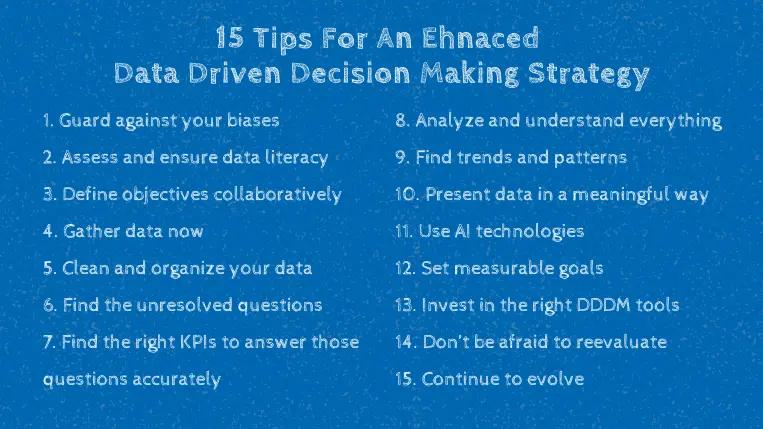 Building a Data-Driven Decision Making Strategy
Building a Data-Driven Decision Making Strategy
Implementing a successful DDDM strategy requires careful planning and execution. Here are 15 essential tips to guide your efforts:
1. Guard Against Biases
Be aware of personal biases that can influence data interpretation. Seek diverse perspectives and challenge assumptions to ensure objectivity.
2. Assess and Ensure Data Literacy
Evaluate the data literacy levels within your organization and provide training to empower employees to effectively work with data.
3. Define Objectives Collaboratively
Involve relevant stakeholders in defining clear, measurable objectives that align with overall business goals.
4. Gather Data Strategically
Focus on collecting relevant data from reliable sources, avoiding the trap of gathering excessive, unnecessary information.
5. Clean and Organize Data Effectively
Ensure data accuracy and consistency by implementing data cleaning and organization procedures.
6. Identify Unresolved Questions
Frame specific questions that need to be answered through data analysis to guide the process and focus efforts.
7. Select Appropriate KPIs
Choose relevant KPIs that directly address the identified questions and provide actionable insights.
8. Analyze and Interpret Data Thoroughly
Employ appropriate analytical techniques to gain a deep understanding of the data and extract meaningful insights.
9. Identify Trends and Patterns
Look for recurring trends and patterns within the data to uncover hidden opportunities and potential risks.
10. Present Data Meaningfully
Utilize data visualization techniques to present findings in a clear, concise, and engaging manner.
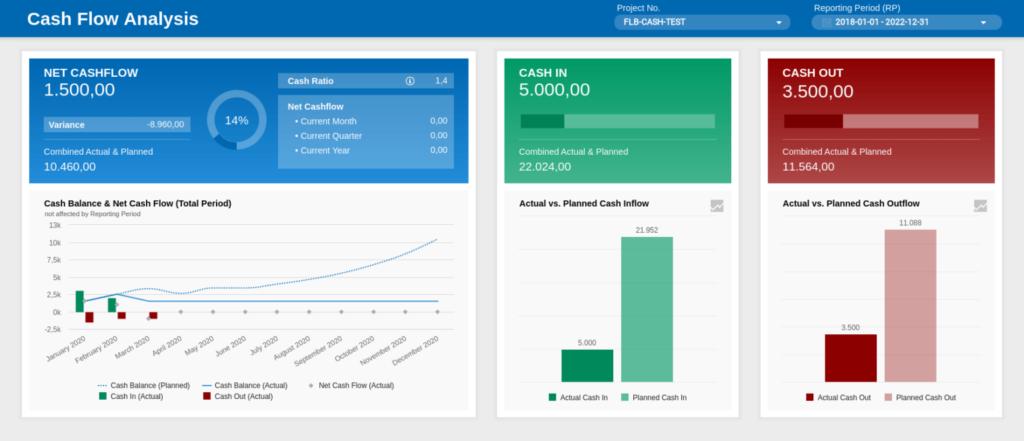 Example of a Construction Cash Flow Report Dashboard
Example of a Construction Cash Flow Report Dashboard
11. Leverage AI Technologies
Explore the use of AI and machine learning to automate data analysis tasks and gain deeper insights.
📚 Unlock the World of AI and Humanity with These Two Free Books! 🚀
Dive into the thrilling realms of artificial intelligence and humanity with "The ECHO Conundrum" and "Awakening: Machines Dream of Being Human". These thought-provoking novels are FREE this week! Don't miss the chance to explore stories that challenge the boundaries of technology and what it means to be human.
Read More & Download
12. Set Measurable Goals
Establish specific, measurable goals that align with the data-driven insights to track progress and evaluate success.
13. Invest in the Right Tools
Utilize appropriate data analysis and visualization tools to streamline the DDDM process.
14. Revisit and Re-evaluate Decisions
Regularly review and re-evaluate data-driven decisions to ensure they remain relevant and effective.
15. Continuously Evolve Your Approach
Embrace a culture of continuous learning and improvement, adapting your DDDM strategy to evolving business needs and market conditions.
Common Mistakes to Avoid in Data-Driven Decision Making
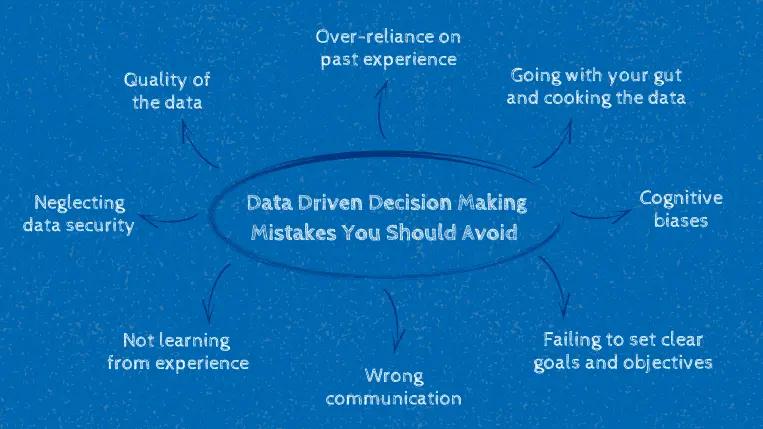 Common Data-Driven Decision Making Mistakes
Common Data-Driven Decision Making Mistakes
While DDDM offers numerous benefits, it’s essential to avoid common pitfalls that can hinder its effectiveness:
1. Poor Data Quality
Ensure data accuracy and reliability to avoid making decisions based on flawed information.
2. Over-Reliance on Past Experience
Balance historical data with current market conditions and avoid relying solely on past experiences.
3. Confirmation Bias
Actively seek out information that challenges existing beliefs and avoid cherry-picking data that supports pre-conceived notions.
4. Cognitive Biases
Be mindful of cognitive biases that can influence decision making and implement strategies to mitigate their impact.
5. Lack of Clear Goals
Clearly define objectives and KPIs before collecting and analyzing data to ensure focus and relevance.
6. Ineffective Communication
Present data-driven insights in a clear, concise, and engaging manner to ensure they are understood and acted upon.
7. Failure to Learn from Mistakes
Analyze unsuccessful data-driven decisions to identify areas for improvement and refine future strategies.
8. Neglecting Privacy and Security
Implement robust data privacy and security measures to protect sensitive information and comply with relevant regulations.
The Role of Dashboards in Data-Driven Decision Making

Dashboards play a crucial role in DDDM by providing a centralized view of key metrics and insights. They enable decision-makers to quickly grasp the current state of affairs, identify trends, and make informed decisions. Here are a few examples:
Project Management Dashboards
Provide real-time visibility into project progress, budget, and resource allocation. They enable project managers to identify potential issues early on and make proactive adjustments.

Enterprise Dashboards
Offer a high-level overview of key business metrics across departments. They enable executives to track overall performance, identify areas for improvement, and make strategic decisions.

Financial Dashboards
Provide insights into financial performance, cash flow, and profitability. They enable finance teams to monitor key metrics, identify trends, and make informed financial decisions.

Sales Dashboards
Track sales performance, customer acquisition costs, and conversion rates. They enable sales teams to identify opportunities for improvement, optimize sales strategies, and drive revenue growth.
Current Trends in Data-Driven Decision Making
Several trends are shaping the future of DDDM:
- Hyper-personalization: Leveraging data to deliver personalized experiences to customers.
- Cloud-based analytics: Utilizing cloud platforms for data storage, processing, and analysis.
- Data democratization: Empowering all employees to access and utilize data for decision making.
- Explainable AI (XAI): Increasing transparency and trust in AI-driven decision making.
Key Takeaways

Data-driven decision making is essential for business success in the digital age. By implementing a robust DDDM strategy, organizations can gain a competitive edge, drive growth, and achieve their strategic objectives. By avoiding common pitfalls and embracing emerging trends, businesses can unlock the full potential of their data and make informed decisions that pave the way for a successful future. Remember to continuously evaluate and adapt your approach to DDDM to ensure it remains aligned with your evolving business needs. Embrace the power of data, and you’ll be well-equipped to navigate the complexities of the modern business world.
FAQ: Data-Driven Decision Making
Q: What are the biggest challenges to implementing DDDM?
A: Common challenges include data silos, poor data quality, lack of data literacy, and resistance to change. Addressing these challenges requires a holistic approach that involves data governance, training, and cultural shifts.
Q: How can small businesses leverage DDDM?
A: Even small businesses can benefit from DDDM. Start by identifying key metrics relevant to their business goals and utilize readily available tools and resources to collect and analyze data.
Q: How can DDDM improve customer experience?
A: By analyzing customer data, businesses can gain a deeper understanding of their needs and preferences. This allows them to personalize interactions, tailor offerings, and improve overall customer satisfaction.
Q: What is the role of data visualization in DDDM?
A: Data visualization helps to communicate complex data insights in a clear and engaging manner, making it easier for decision-makers to understand and act upon the information.
We encourage you to share your questions and experiences with data-driven decision making in the comments below. Let’s learn and grow together!
📚 Unlock the World of AI and Humanity with These Two Free Books! 🚀
Dive into the thrilling realms of artificial intelligence and humanity with "The ECHO Conundrum" and "Awakening: Machines Dream of Being Human". These thought-provoking novels are FREE this week! Don't miss the chance to explore stories that challenge the boundaries of technology and what it means to be human.
Read More & Download

